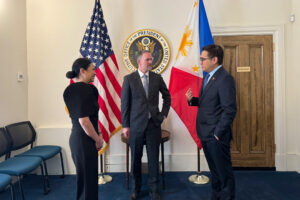The Philippines is in a “good” position in trade negotiations with the US, Malacañang said on Tuesday, after President Donald J. Trump sent tariff letters to a number of countries in Southeast Asia.
“In our opinion, yes (we are in a good place), because the Philippines and the US, have reached an agreement that there will be cooperation on economic development,” Palace Press Officer Clarissa A. Castro told reporters at a briefing.
Asked where Manila and Washington are in negotiations, Ms. Castro quoted Secretary Frederick D. Go, Special Assistant to the President for Investment and Economic Affairs and one of the trade negotiators, as saying there are no updates as yet, with negotiations still ongoing.
Trade negotiators are bound by a confidentiality agreement.
Mr. Trump sent out tariff letters to Japan and South Korea on Monday, announcing both their rates on social media as 25%. He also sent similar letters to Myanmar (40%), Laos (40%), Indonesia (32%), and Malaysia (25%).
On April 2, the White House initially announced “reciprocal” tariffs of 24% on Japan, 25% on South Korea, 44% on Myanmar, 48% on Laos, 32% on Indonesia and 24% on Malaysia. The Philippines had initially been assigned a rate of 17%.
The reciprocal tariffs were suspended pending negotiations with various trade delegations, while a 10% tariff applied in the interim to most trading partners.
Vietnam has since been assigned a 20% as one of the first two countries to conclude a trade deal with the US.
Mr. Trump said changes to the tariffs charged on trading partners take effect on Aug. 1, though he was open to further negotiations.
Secretary of State Marco Antonio Rubio, will visit Asia for the first time on the occasion of an Association of Southeast Asian Nations (ASEAN) meeting next week.
Ms. Castro said there are no details yet on what the regional bloc will discuss with Mr. Rubio.
Reinielle Matt M. Erece, an economist at Oikonomia Advisory and Research, Inc., said the Philippines’ competitiveness in international trade may continue to improve.
“Increased competitiveness is beneficial for exports and economic growth,” he said via Viber.
“Now that competitiveness in terms of price is seen to be in favor of the Philippines, the next step is to improve the country’s industrial sector to produce even better products that can also compete in terms of quality,” he added.
The Foreign Buyers Association of the Philippines has warned that Philippine exports will struggle to compete if the US restores its 17% reciprocal tariff rate, especially after Vietnam secured its deal for a 20% tariff. — Chloe Mari A. Hufana

